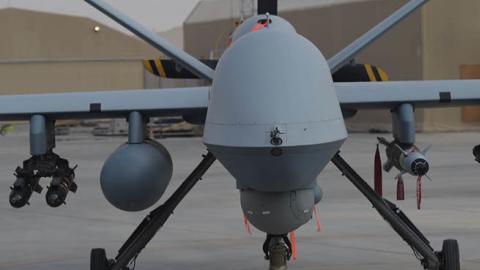From World War II until today, America’s unsurpassed military power has been built on air supremacy. All experts agree that the future of air power in the 21st century will be remotely piloted or “unmanned” aerial systems (UAS) — what the public calls drones.
The public has been conditioned to think of these military drones as a way to target and kill terrorists. But they are far more versatile and important. Specimens like the Predator, Reaper, and Global Hawk are quiet, relatively unobtrusive, and can stay aloft at heights of 40,000 feet or more for up to 40 hours at a time. Their extended capability and altitude — plus cutting-edge sensors and communication links — have become indispensable for keeping us informed about what bad guys are doing around the world — with their pilots sitting safely at their desks.
These UAS will also play an important role in ballistic-missile defense against rogue nations like North Korea and Iran. A program currently on the drawing board in which I’ve been involved will use UAS platforms armed with a hyperkinetic two-stage interceptor missile to shoot down North Korean missile launches in their early “boost” phase far more effectively and cheaply than today’s “terminal”-phase missile interceptors.
They can also become the tools for sustained air campaigns against enemy forces on the ground. What the Air Force and Marines did with devastating effect in World War II, Korea, Kosovo, and Desert Storm will now be possible with armed UAS without putting a single pilot at risk.
With all these opportunities, the United States ought to be committing major resources to securing the future of autonomous air power for ourselves and our allies — and dominating the large drone market that’s expected to grow to $32 billion in the next ten years.
Unfortunately, an outdated international agreement is holding us back, and giving the lead to our deadliest competitor: China.
The problem is an agreement — not, one notes, a signed or ratified treaty — known as the Missile Technology Control Regime (MTCR). Drawn up in 1987, it was designed to limit the proliferation of technology that would spark a ballistic-missile arms race, especially those that can carry weapons of mass destruction. That’s a laudable aim. The problem is that a provision of the MTCR includes UAS in the category of missile technology capable of carrying a 500-kilogram payload at least 300 kilometers. MTCR signatories like the U.S. are forbidden to export such technology, even to trusted allies. That restriction dates back to 1992, when the fear was that large, unmanned aircrafts would be used for kamikaze-style terrorist attacks. What it actually means today is that U.S. allies like South Korea and Britain can’t buy Global Hawks or Predators except through special executive waiver: a time-consuming bureaucratic process.
China, however, does not recognize the MTCR and is free to sell its drones (most of them are stolen copies of ours) to allies who are blocked from buying in the U.S.
A new report authored by Heather Penney at the Air Force Association’s Mitchell Institute highlights the absurdity, and peril, arising from this development. When the United Arab Emirates and Jordan couldn’t buy our UAS, for example, they wound up buying from China. As UAS become increasingly important to air forces around the world, other allies are bound to do the same. In fact, a report from the Defense Intelligence Agency last year pointed out that China “faces little competition for sale of such systems” because of MTCR.
This has huge implications, and not just for lost business for U.S. companies. It cripples the principle of interoperability. If allies, even NATO allies like Turkey, are using China-built or designed systems, we won’t be able to share data and intelligence — even in emergency battle conditions.
How do we fix this problem?
First, reform MTCR — by executive order if necessary. If Congress and the State Department, which oversees the agreement, aren’t willing to take the blinders off on MTCR, then the president can and must. Let aircraft be aircraft, and missiles be missiles: The two should never be intermingled in the same control regime.
Second, use the principle of UAS interoperability as a way to strengthen alliances, as a force multiplier for our own military, but also a guarantor of security for our friends. Secure interoperability will be the key to halting China’s bid for UAS hegemony, especially since China has no allies and we do.
Third, the Mitchell Institute is named after Colonel Billy Mitchell, the prophet of manned air power. What’s needed today is a Billy Mitchell for unmanned airpower, someone with the guts and vision to explain how versatile and powerful these tools will be for American national security — and at a fraction of the cost of manned aircraft.
The alternative is that China will win this game of drones, with truly dangerous implications for the future.
Read in National Review

















